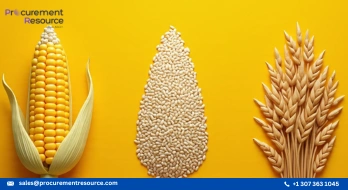Wheat and Rice Output in India are at an All-Time High

According to a US Department of Agriculture's Foreign Agricultural Service study, India is on track for a fourth record wheat harvest and near-record rice output in 2020-21. Wheat production is expected to be at 105 million tonnes, whereas rice production is projected to reach 117 million tonnes.
As per the USDA, improved planting and productivity prospects were aided by soil moisture, low temperatures, and evenly distributed rainfall during the newborn stage. Due to the development and increase of surface planted to new, better yielding varieties and usually good weather conditions, wheat output has been above trend for the previous four years.
Due to abundant domestic supply, India's wheat consumption is likely to rise to 93 million tonnes in 2020-21, following a period of stagnation. The USDA notified that the wheat utilisation for feed and residue is projected to be 6.5 million tonnes, up from 6 million tonnes the previous year.
Wheat inventories were inflated more than three times as compared to what was anticipated due to record harvests and government procurements. Ending stockpiles for 2019-20 are estimated to be 24 million tonnes, up more than 7 million tonnes from last year and more than three times the minimal buffer reserve of 7.5 million tonnes, assuming regular offtake in March.
Good weather also aided rice output, which is supposed to reach 117 million tonnes in 2020-21, with a rough rice yield of 4 tonnes per hectare. Rice output, like wheat production, has risen above the trend line because of the higher yields. According to the USDA, cultivated rice estate has plateaued over the previous decade due to increasing land demand from urbanisation and higher-value crops.
However, according to the USDA, output has increased rapidly due to increased yields as a result of the new and improved range, better agronomic techniques, and irrigation facility development. Despite this, India's total rice harvest are still significantly below the global average, with considerable fluctuations in productivity across the nation and among the key producing states.
Analysts believe that by extending irrigation infrastructure and enhancing the development and use of newer kinds and technologies, the country's rice yield may be increased even further.
Rice consumption is expected to reach 102 million tonnes in 2019-20, up 3 percent from the previous year. The USDA said that rice consumption is predicted to rise to 108 million tonnes in 2020-21 as the government pushes for more subsidised rice.
Rice exports are anticipated to rebound to 12 million tonnes in 2020-21, thanks to increased exportable supply. According to a forecast from the US Department of Agriculture's Foreign Agricultural Service, India will produce a record 305.4 million tonnes of grain in 2020-21, up 8 million tonnes from last year's record crop (USDA).
Rice, wheat, corn, and pulses are all producing at record levels, driving up output. Despite concerns about the extended lack of monsoon rains, rice output will remain around 121 million tonnes in 2021-22. Rice exports are projected to reach 19 million tonnes in 2020-21.
Exports are estimated to drop to 15.5 million tonnes in 2021-22 due to constrained local supply and more typical price parity. Wheat output in 2021-22 is believed to be between 98 million and 105 million tonnes, down from the previous high of 107.9 million tonnes in 2020-21.
The USDA stated that heat stress during harvest in partly irrigated wheat-producing states is blamed for the lower output. According to the USDA, government wheat stocks have exploded due to back-to-back record harvests.
As of June 1, stockpiles were likely to be 60.3 million tonnes. The USDA mentioned that the government wheat stocks have exploded due to back-to-back record harvests. As of June 1, stockpiles were likely to be 60.3 million tonnes.
According to the USDA, market sources suggest that 15 million to 18 million tonnes of wheat inventories are kept in the open on wooden pallets with minimal plastic covering. The government is under enormous pressure to dispose of extra wheat inventories to reduce losses and free up storage space for the rice harvest in MY 2021-22.
Under food security initiatives, the government distributes 2.2 million tonnes of wheat each month. A COVID-19 relief programme will also reduce stockpiles by 8 million tonnes. As per the USDA sources, the government intends to sell 7.5 million tonnes of food grain to commercial millers and announce another cost-free food grain release. The USDA stated that by the end of 2021-22, this should help reduce inventories down to a more reasonable level of 27 million to 28 million tonnes.



.webp)